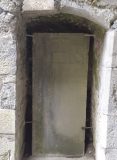Simon Brodin
This gravestone is located in an alcove on the north wall of the sacristy and it reads:
HERE LIES THE BODY OF THE Rd SIMON BRODIN O[F]M WHO DEPD THIS LIFE THE 15TH OF JANY 1792 IN THE 89th YEAR OF HIS AGE REQUIESCAT IN PACE
After their eviction from Ennis Friary and before they opened their modern church on Francis Street, the friars in Ennis were located in various sites around the town. There are references to friars residing in Scabby Lane, in Church Street, in Brewery Lane and in Lysaght’s Lane where a plaque commemorates their former presence there. Lysaght’s Lane seems to have been where they were before they moved to Bow Lane in 1830 and perhaps this is where Fr. Simon Brodin lived.
The Brodins or O’Bruodins were the hereditary genealogists, historians and bards of the O’Briens, and they seem to have had a very strong link with the friars of Ennis. Anthony Bruodin a friar, “born c.1618 in Kilraghtis parish and in 1680, died of plague while resident in the Irish College in Prague” (McInerney, 2017), has written descriptions of our friary in the 1600s. He wrote that the Brodins had a tomb alongside the O’Briens in the chancel and he also wrote of the last friar to live on the site here, Dermot O’Bruodin. Dermot O’Bruodin will be forever remembered as “the mad friar”. When he returned from his travels on the continent at the turn of the 17th century, instead of going into hiding like his other brethren, Dermot continued to preach openly around the streets of Ennis wearing his full Franciscan habit. This was an offence that was punishable by death and he was promptly arrested by the Protestant authorities at the time. Before he could be tried and condemned, Donogh O’Brien, the 4th Earl of Thomond, stepped in and had Dermot declared legally insane. He stated that no sane man would have been preaching as Dermot was, knowing that they could be put to death for doing so. The Earl probably did this on account of the strong bond between the O’Briens and the O’Bruodin families. As a consequence Dermot was allowed to live in the friary and also to say mass in his room there until his death in 1617.
References:
Antonius Bruodinus, Propugnaculum Catholicae Veritatis Libris X Constructum, in Duasque Partes Divisum. Pars Prima Historica in Quinque Libros (Prague, 1669)
Luke McInerney, ‘A Most Vainglorious Man: The Writings of Antonius Bruodin’, Archivium Hibernicum, Vol. 70, 2017
Patrick Conlan OFM, ‘Franciscan Ennis’, 1984
Fr. Paul Mary OFM, ‘The Old Friaries of Ennis and Quin’, Wexford, 1954

